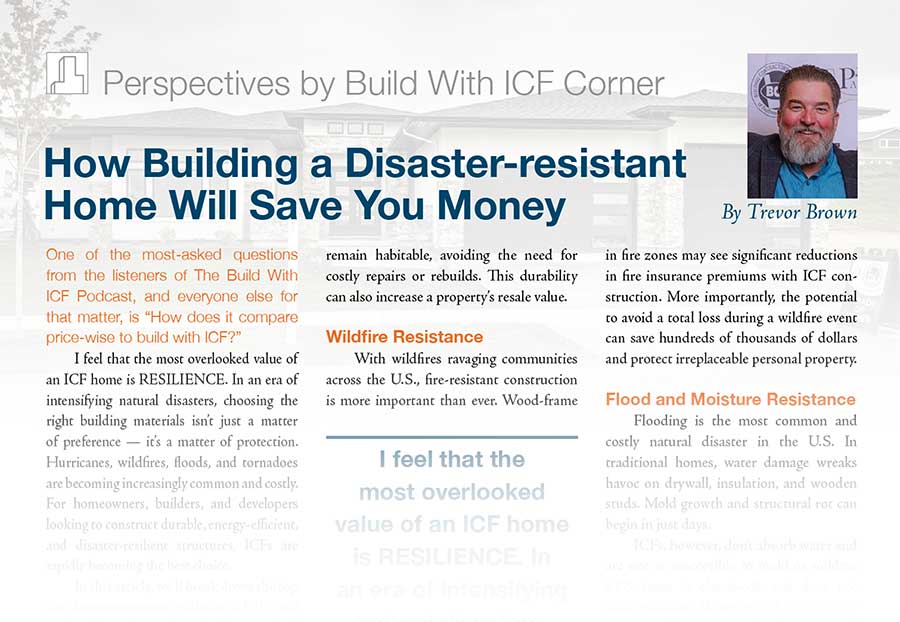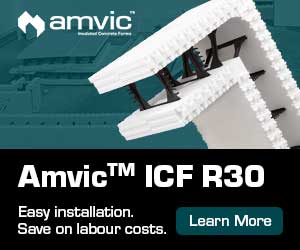By Trevor Brown
I feel that the most overlooked value of an ICF home is RESILIENCE. In an era of intensifying natural disasters, choosing the right building materials isn’t just a matter of preference — it’s a matter of protection.
One of the most-asked questions from the listeners of The Build With ICF Podcast, and everyone else for that matter, is “How does it compare price-wise to build with ICF?”
I feel that the most overlooked value of an ICF home is RESILIENCE. In an era of intensifying natural disasters, choosing the right building materials isn’t just a matter of preference — it’s a matter of protection. Hurricanes, wildfires, floods, and tornadoes are becoming increasingly common and costly. For homeowners, builders, and developers looking to construct durable, energy-efficient, and disaster-resilient structures, ICFs are rapidly becoming the best choice.
In this article, we’ll break down the top five disaster-resistant qualities of ICFs and explore how this modern building method isn’t just about resilience — it’s also a smart long-term investment.
Hurricane and Tornado Resistance
Wind events are some of the most destructive natural disasters in the U.S., with hurricane seasons growing longer and “tornado alley” expanding. Standard wood-frame houses often can’t withstand wind speeds exceeding 120 mph without sustaining major damage. In contrast, ICF walls are proven to resist wind speeds of over 200 mph, equivalent to EF5 tornadoes.
The combination of reinforced concrete and insulated concrete forms creates a solid wall with no weak points. Unlike traditional wood studs that can snap or be pulled apart, ICF walls remain intact even when exposed to flying debris and pressure differentials.
ICF homes in hurricane-prone areas often qualify for insurance discounts due to their superior strength. Additionally, after a storm, ICF structures are more likely to remain habitable, avoiding the need for costly repairs or rebuilds. This durability can also increase a property’s resale value.
Wildfire Resistance
With wildfires ravaging communities across the U.S., fire-resistant construction is more important than ever. Wood-frame structures offer little defense against flames, while ICFs have a 4-hour fire-resistance rating and are nearly impervious to ignition. Concrete doesn’t burn, and EPS foam used in ICFs is treated with flame retardants. In testing, ICF walls have withstood temperatures of over 2000°F, far beyond the threshold at which most building materials fail. Embers and flames simply can’t penetrate the solid core of an ICF wall. And with additional precautions of Vulcan Vents for soffits and fire-resistant roofing materials, ICF homes remain standing while surrounding homes do not. In most cases, homeowners in fire zones may see significant reductions in fire insurance premiums with ICF construction. More importantly, the potential to avoid a total loss during a wildfire event can save hundreds of thousands of dollars and protect irreplaceable personal property.
Flood and Moisture Resistance
Flooding is the most common and costly natural disaster in the U.S. In traditional homes, water damage wreaks havoc on drywall, insulation, and wooden studs. Mold growth and structural rot can begin in just days.
ICFs, however, don’t absorb water and are not as susceptible to mold or mildew. EPS foam is closed-cell and does not wick moisture. When paired with proper waterproofing, ICF foundations and walls can withstand prolonged exposure to floodwaters without losing structural integrity or harboring mold.
Cleanup after a flood is dramatically easier with ICFs — often requiring just power washing and drying. Homeowners can avoid mold remediation costs, health risks, and expensive structural replacements while maintaining the value and habitability of their homes.
Earthquake Resilience
In seismically active regions, structural flexibility and strength are key to surviving earthquakes. Traditional frame construction can shear, twist, or collapse under lateral forces. ICF walls, with continuous steel reinforcement, have proven to perform exceptionally well in seismic tests and real-world earthquakes.
ICFs create a continuous, reinforced concrete core that behaves as a single unit under stress. This allows the structure to move with seismic forces without cracking or separating, especially when designed with seismic codes in mind. ICF is widely known to be up to 10 times stronger than stick-frames. An ICF home’s resilience to earthquakes can reduce or eliminate structural damage, preventing high repair costs or complete rebuilds. In many cases, residents can stay in their homes immediately following a quake, avoiding temporary housing and displacement costs.
Pest and Vermin Resistance
My avid listeners know termites and mice are a hot button for me. People love to ask me about them. While not technically a “disaster,” infestations can be financially and structurally devastating over time. Termites, rodents, and other pests find ample food and nesting opportunities in traditional wood-frame structures.
ICF walls contain no organic material and are nearly impenetrable to pests. The concrete core is inaccessible and inedible to insects and rodents. EPS foam is also non-nutritive and tightly sealed within the wall system. Without pathways, moisture, or food, pests can’t thrive. Avoiding pest damage means no structural repair bills, no exterminator fees, and no ongoing treatments. This protection preserves both the safety and value of a home over decades.
Long-Term Energy Savings
While not a disaster in the traditional sense, skyrocketing energy costs can devastate a homeowner’s budget. ICF walls offer an extremely efficient envelope thanks to the combination of insulation on both sides of the concrete core. More importantly, the thermal mass of the concrete moderates indoor temperatures, reducing the need for heating and cooling.
The dual insulation layers combined with airtight construction minimize thermal bridging and reduce HVAC loads. Homes maintain stable temperatures year-round, even in extreme climates. ICF homeowners often see 30% to 50% reductions in energy bills, which adds up significantly over time. Over a 30-year mortgage, this can translate into tens of thousands of dollars in energy savings.
A Smarter, Safer Investment
For the homeowner, choosing ICF construction isn’t just about building a house — it’s about building a legacy of security, efficiency, and peace of mind. Consider these long-term financial benefits:
- Lower insurance premiums due to disaster resilience
- Reduced maintenance and repair costs after storms or floods
- Significant energy savings year after year
- Higher resale value thanks to durability and performance
- Potential tax credits or incentives for energy-efficient construction
While ICF construction may cost slightly more upfront — typically 2% to 5% more than wood framing — the long-term savings and durability far outweigh the initial investment. And as extreme weather events become more frequent, building smart today means avoiding disaster tomorrow.
Natural disasters are unpredictable — but your home doesn’t have to be vulnerable. Insulated Concrete Forms offer unmatched strength, safety, and savings, making them a top choice for forward-thinking builders and consumers alike. Whether you’re constructing a new custom home, a multi-family development, or a commercial building, ICFs provide a future-proof solution that protects what matters most.
The next time you think about building, ask yourself: Will your walls still be standing after the next disaster? With ICFs, the answer is far more likely to be yes.

Trevor Brown
Trevor Brown is the owner and operator of Innovative Building Products, a multiline ICF and ICF accessories distribution company. He has been in the ICF industry for over 20 years starting as an installer and distributor. He has managed the Western U.S. for an industry-leading ICF company and is now an independent consultant for ICF builders and homeowners across the country. He is also the co-host of the Build With ICF Podcast, which can be found on the website www.buildwithicf.com.








